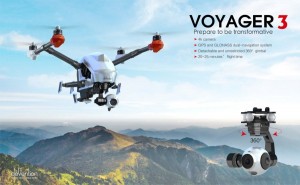Walkera Voyager 3 Review and Analysis
Walkera has been famous for putting out both RC and GPS-enabled minidrones on the market. The Scout X4 drone, the Tali H500, and the QR Ladybird V2 are just a few models that come to mind. But now, there’s a new drone model that would be the talk of the town, and it is set to compete with the DJI Inspire 1. Find out more about this drone through our comprehensive Walkera Voyager 3 review.
Inside The Box
The Voyager 3’s release generated quite a buzz in the drone enthusiast community. On one hand, there are fans who heralded this as the next star of high-end quadcopters. On the other hand, some people touted it as a mere rip-off of the DJI Inspire 1, which had an earlier release date. Let’s see which side wins in this review.
When you buy this machine from the Walkera’s GPS Series, you’ll receive everything you need to fly it right away. It contains the main drone, complete with a battery and its charger. It also comes with the standard Devo F12E transmitter, which allows for some FPV navigation.
Straight out of the box, the design is highly similar to the Inspire 1. It has nearly the same retractable landing gear and gimbal with an unobstructed 360° view. Its camera records videos at the same quality as well. 
But, Walkera added some unique features to the Voyager 3. For one, it has a visual indicator of the UAV’s battery life. It has some nifty navigation-related features that the Inspire 1 doesn’t have. The machine is more of a close competitor of the DJI UAV, rather than a close copy.
Battery
If we pit the Walkera Voyager 3 vs DJI Inspire 1, it’s a stalemate when it comes to the battery. Both machines clock in an advertised flight time of 20-25 minutes. In actuality, of course, the length of time you can play with these UAVs depends on the weather. But as far as comparative tests go, the Voyager 3 outlasts the Inspire 1 by a very small margin.
Nonetheless, the flight time of the Voyager 3 is impressive. Despite its heavy build and bulky form, the machine is powerful enough to last at least 20 minutes in the air, even amid the occasional gusts.
Camera
The camera is another strong point of this drone. It can record 4K video at 30fps and 1080p clips at 60fps. This is the same output quality the Inspire 1 dishes out. Where they differ is in terms of color. The Voyager 3 has more vibrant shades and a slightly better sharpness than the Inspire 1.
Navigation
The navigation is where the tussle between the Inspire 1 and the Voyager 3 becomes an all-out brawl. Let’s start with the former, which has the capability to fly indoors. It also has the Optical Flow technology that allows the UAV to maneuver through solid obstacles.
These are something that the Voyager 3 lacks, BUT it has other useful features that make up for it. For instance, this Walkera UAV is a dual-navigation RC quadcopter. This means that the machine uses both GPS and GLONASS at the same time to provide more accurate location data.
It is capable of flight planning, automatic cruise, and smart take-offs and landings as well. This also features the “Follow Me” technology, which makes the drone follow the user automatically. In the case of navigation, it is another stalemate. The decision on which is the better bird depends on how you plan on flying the machine.
Safety
In terms of safety, the Walkera Voyager 3 is a little wobbly. Design-wise, the quadcopter is sturdy enough to withstand minor crashes, with only the propellers suspect to breaking upon contact.
Some pilots, however, complain about the heat that the machine generates. Based on different reports, the motor is prone to catching fire, especially during extended flights. The heat is something we have noticed with this machine. After an hour of flying, the UAV heated up quite intensely. While it didn’t burn or anything, we had to let it cool down for a few minutes before picking it up.
Walkera Voyager 3 Specs
| Weight | ~3000 g |
| Battery | 2 pcs 8S LiPo battery (3000 mAh, 29.6V) |
| Camera | 4K video output at 30 fps, 1080p at 60 fps |
| Flight Time | 20-25 mins |
| Control Range | Pitch rotation -120° ~+60°; horizontal ±360° |
| Flight Speed | 22 m/s |
| Motor | Brushless motors |
The Verdict
As what our Walkera Voyager 3 review has found out, this Walkera drone gives the DJI Inspire 1 a run for its money. Both birds cater to the prosumer demographic, and the battle is pretty close. Each of the two quadcopters has a set of nifty features that the other doesn’t have. Design-wise, both are highly similar as well. Then again, these high-end features come with a high price. You have to make the most of these advanced features to justify the costs you’ll have to pay.


There are no comments yet, add one below.